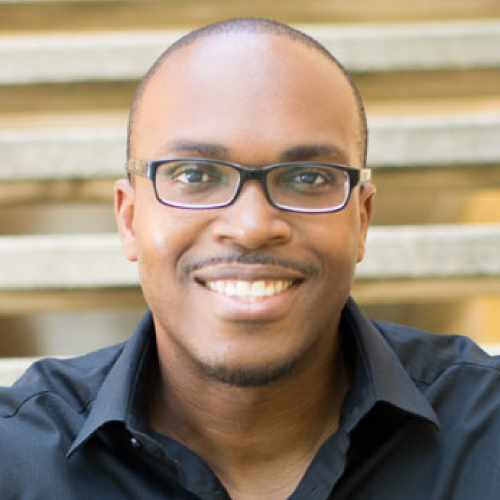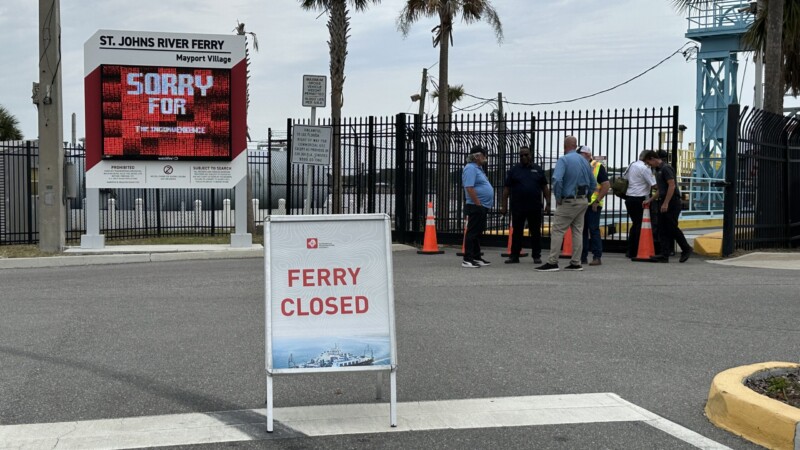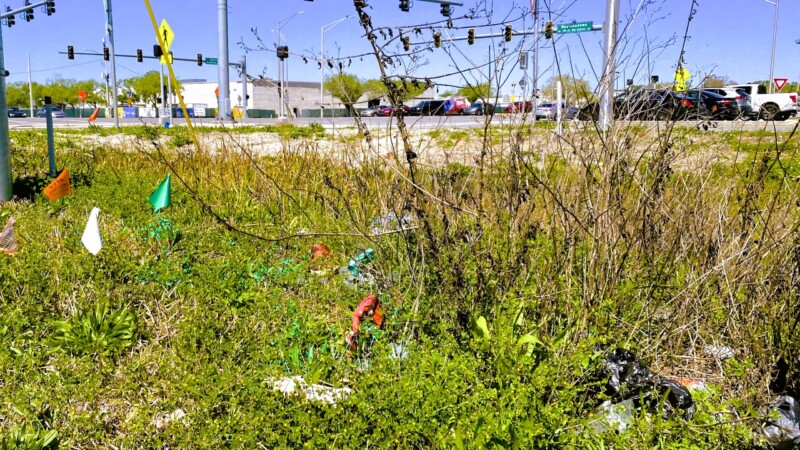
The history and heritage of Jacksonville’s many Gullah Geechee descendants have been largely overlooked, with little recognition given to the community. According to the Gullah Geechee Heritage Corridor Commission, the Gullah Geechee are descendants of Central and West Africans who were enslaved and brought to the Americas from the late 1600s to 1866, bringing with them traditional foodways, customs, arts, crafts, language and other West African traditions they incorporated during and after enslavement. They built and sustained rice, indigo and Sea Island cotton plantations stretching from the Carolinas to Jacksonville in a region commonly known as the low country.
The city of Jacksonville is the largest city at the southernmost point of the Gullah Geechee Cultural Heritage Corridor, a federal National Heritage Area that extends from Pender County, North Carolina, to St. Johns County, Florida. In Jacksonville, the Eastside has one of the largest concentrations of historic-age buildings associated with a Gullah Geechee community in the city of Jacksonville.
Tomorrow, weather permitting, the Jacksonville Historic Preservation Commission (JHPC) is scheduled to consider a Florida National Register Nomination Proposal prepared by the State Historic Preservation Office (SHPO). If supported by local preservation and elected officials, the Eastside Historic District will be considered for nomination by the Florida National Register Review Board at its Nov. 10th board meeting.
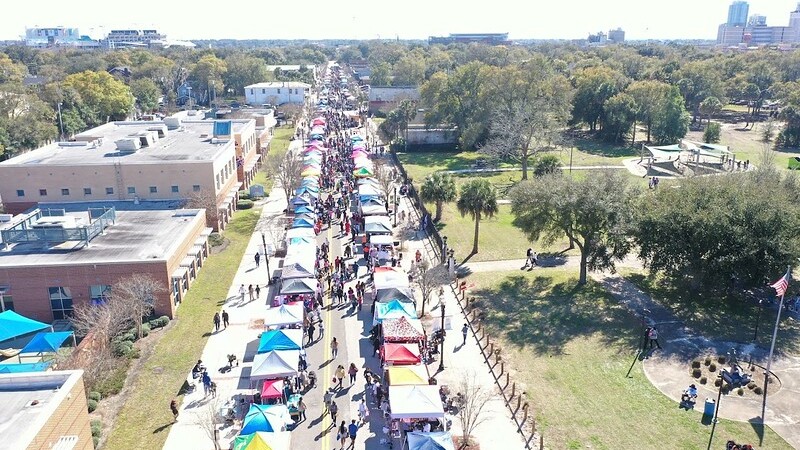
According to SHPO, the establishment of an Eastside Historic District will greatly increase public awareness and support for the preservation of the prominent African American neighborhood. In addition, by creating a district, it will increase the opportunity for more property owners to apply for a federal tax credit because the area contains approximately 678 contributing properties that may not qualify for individual listing on the National Register of Historic Places. Since the 1990s, a significant amount of the historic building stock in the Eastside neighborhood has been demolished. Therefore, it is essential that the remaining buildings be preserved in order to continue contributing to the historic ambiance of the area for the benefit of generations to come.
To support this nomination, a National Register of Historic Places Registration Form detailing the neighborhood’s history was recently prepared. Here are a few interesting, overlooked facts from that history:
Shotgun houses: The most common architectural style
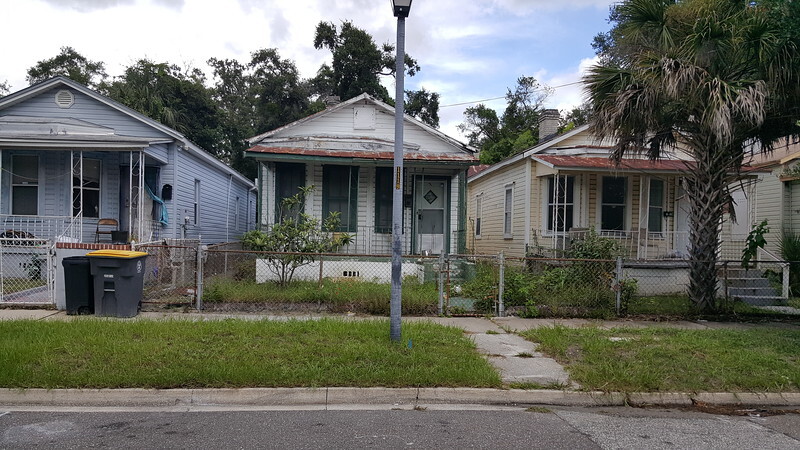
In the Eastside Historic District, frame vernacular is the most common architectural style, with approximately 445 contributing frame vernacular buildings found in the district. Of these buildings, shotgun is the most predominant subtype. Commonly referred to as shotgun homes, residences of this type are characterized by their long and narrow plans, just one room wide, one story high and two to three rooms deep. The origins of the shotgun home in the United States can be traced to New Orleans, where it first appeared after thousands of Haitians migrated to the city in the early 19th Century following the Haitian Revolution. The building type is believed to have emerged in Haiti as early as the 1700s as a combination of West Indian aboriginal and West African architectural styles.
Once adopted in the United States, the building type became popular throughout the American South. Shotgun homes could easily adopt popular stylistic elements of the time, from ornate folk Victorian style trim to craftsman style porches. Because of its small size and simple layout, the shotgun home was often constructed as low-cost housing for the working class throughout the South. Typically, shotguns were constructed close together, with several homes on one lot. The shotgun type was particularly prevalent in African American communities, in both rural and urban areas. The Haitian origin of the shotgun home was not part of architectural and historical discourse until the 1970s, when American folklorist John Michael Vlach began publishing research concerning the type’s history. The shotgun home is now more widely recognized as an African American cultural, architectural form prevalent in historically Black communities.
Quotes from this document provide additional insight on this style of housing would have made it to the Eastside and other low country communities:
“Except for the recollection of one former slave in the 1930s, only one scholar has provided detailed evidence for African architectural styles in the Southeast. In his examination of the ‘shotgun’ house still extant in many Southern communities, John Vlach has convincingly demonstrated that this house type can be traced to New Orleans where many Haitian slaves came in the early 19th century. Many slaves whose homeland was in Yoruba, in what is now part of Nigeria, brought this house type with them to the New World.
“In addition to these specific structural features there are other landscape features surrounding African structures that should be noted. It was common that African structures noted by 17th, 18th and even 19th century travelers show that structures were characteristically small by European standards — usually 300 square feet or less. However, this did not necessarily denote low status or poverty. Most activities occurred outside the house in a compound. Everything from food preparation, eating, and socializing was carried on in the open air. The dwelling was a place reserved essentially for sleeping or protection from bad weather.”
Jacksonville’s first park for African Americans
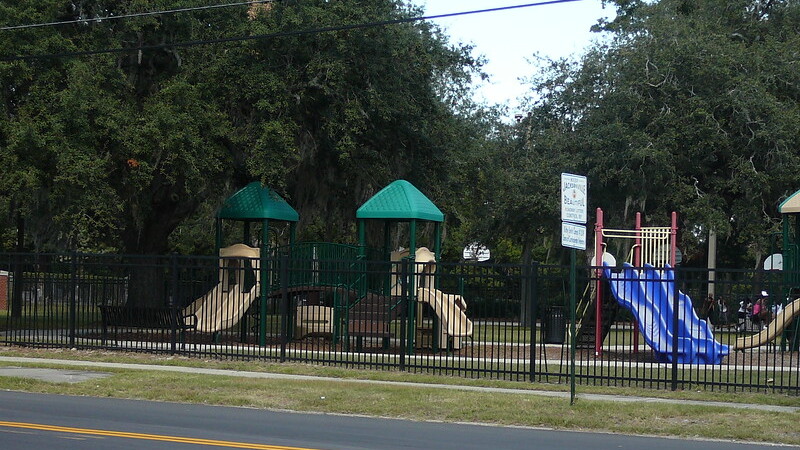
Oakland Park is the one contributing site in the proposed Eastside Historic District that isn’t a building. Oakland Park is an approximately 1-acre city park located in the southwestern portion of the district. The park opened on July 4th, 1918, as the first playground established by the city of Jacksonville for African American children. The park opening in the historically Black Oakland neighborhood was celebrated with a parade, beginning at Stanton High School in Downtown Jacksonville, west of the district. At the time of its opening, the park was described as having outstanding trees and being bounded by two cemeteries, streetcar tracks and a railroad crossing. Today, the park is bounded by a metal fence and two entries through brick piers, one off of Ionia Street and one off of East Union Street. The park has retained its outstanding trees and is shaded by numerous large Spanish moss-draped oaks. A swing set, playground and basketball court are located in the park and are accessed by paved walkways.
Site of industrialized slavery
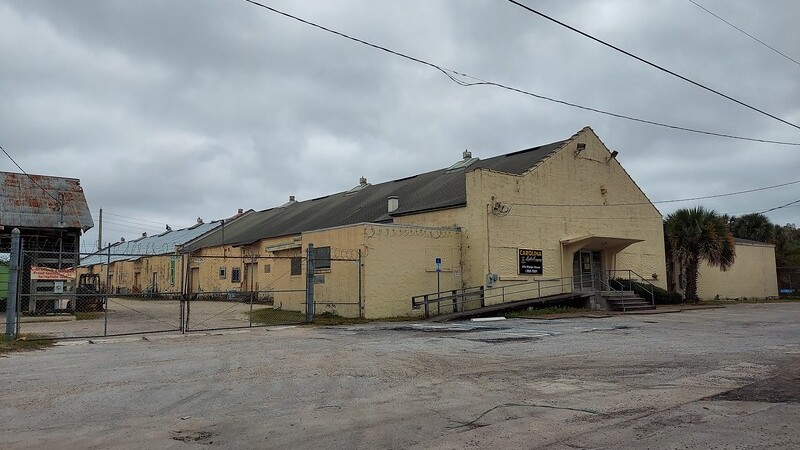
Although the Eastside’s development officially began with the plotting of Oakland by Jesse Cole in 1869, there was already an established Gullah Geechee community present.
Jacksonville prospered as the best port on the St. Johns River following the end of the Second Seminole War. As Jacksonville’s population rose, St. Augustine fell into decline because 19th Century vessels were too large for its harbor. With Jacksonville emerging as a lumber port and a place where surrounding plantations sent crops to market, St. Augustine’s elite began to shift their ambitions, capital and enslaved to Jacksonville. By 1860, 42% of Jacksonville’s population was enslaved. Bondsmen worked as loggers, turpentiners, pilots, stevedores, carpenters, masons and mill hands.
The majority of Jacksonville’s pre-Civil War mills were located on the Eastside’s riverfront, including Bellechasse & Finnegan’s mill, which was owned by Joseph Finegan. Finegan was the Confederate general who led the Confederacy to victory at the Battle of Olustee. Finegan’s Eastside mill operated from 1851 to 1907. His use of enslaved labor at this mill is highlighted in this document:
“Estates were an important source of hired slaves in northeast Florida as elsewhere in the Old South. Joseph Finegan of Jacksonville, executor of the estate of his wife’s first husband, sent slaves to work on the steamboat Welaka but took them off in 1852. By not taking the high wages paid on the dangerous steamboats and employing the slaves in his own new sawmill instead, he came under criticism for his handling of the estate, only to feel vindicated when the steamboat Magnolia exploded in 1852 killing great numbers of hired slave hands.”
Boat and shipbuilding are also historically linked to the neighborhood and continue to be major employers. According to the 1850 slave census, steamboat Capt. Charles Wiley, who donated land for Old City Cemetery and sold land to Jessie Cole for the Oakland plat, also profited from enslaved labor.
Gullah Geechee foodways
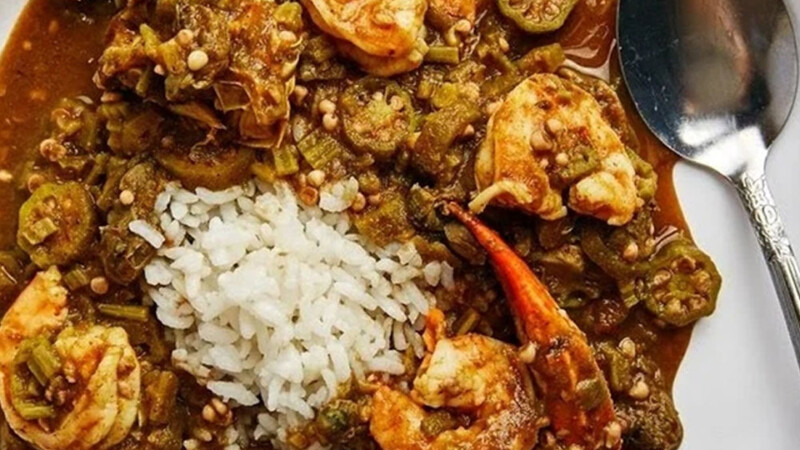
Through their “African cultural expressions,” the Gullah Geechee have influenced the cultural development of the Eastside. The traditional Gullah Geechee diet consisted of items available locally such as vegetables, fruits, game, seafood, livestock; items imported from Europe, items imported from Africa during the slave trade (okra, rice, yams, peas, hot peppers, peanuts, sesame “benne” seeds, sorghum and watermelon), and food introduced by Native Americans such as corn, squash, tomatoes and berries. Rice became a staple crop for both Gullah Geechee people and whites in the Southeastern coastal regions.
For several decades, many neighborhood residents engaged in subsistence farming, which they supplemented with seafood from the nearby river and shellfish gathered from the marshes. Culinary dishes commonly attributed to Southern culture, such as garlic crabs, crab pots, seafood boils and shrimp and grits are actually traditional Gullah Geechee foodways. Recipes such as these were created not only as an expression of the Gullah Geechee culture but also out of necessity. Many of the Gullah Geechee were enslaved at plantations throughout the South and learned to “live off the land and environment” by combining rations like rice and grits with other available resources from nearby fertile waters, such as shrimp, fish, blue crab and oysters. Saundra Morene, president of the Jacksonville Gullah Geechee Nation Community Development Corp., an organization working to preserve the community’s traditions, grew up in the Eastside and remembers her family growing vegetables in a community garden and trading them for others grown by members of the community. She notes that fresh, seasonal ingredients and community sustainability were key elements of Gullah Geechee foodways for her family while living in the Eastside. When reflecting on her childhood home, Morene stated that “the house had a lot of flavors going through it” and that “whatever was in season is what we ate.’
In his autobiography, A. Philip Randolph, who was raised in the Eastside, spoke of his father having fish and chicken fries in the 1890s to raise money for their new church building. In the early 20th Century, Eastside resident Charles H. Anderson was so successful as an oyster and fish dealer that he went on the open one of Florida’s first Black-owned banks in LaVilla.
As time has gone on, the neighborhood has urbanized and has been intentionally cut off from the river. In addition, nearby marshes were filled in for additional development. Nevertheless, dishes like crab pots, garlic crabs, fried shrimp, fish, oysters and soul food continue to serve as a focal point of the Eastside restaurants, reunions, special events and communal get-togethers. Also, fishing, including cast net fishing, is a form of subsistence farming that can be witnessed daily behind the WJCT Public Media building, within walking distance of the survey area.
Gullah Geechee influences on religion and music
One particularly powerful element of Gullah Geechee culture is the traditional call-and-response, or shout-form, of music perhaps best known for its prevalence in religious services. Call-and-response is a form of interaction between a speaker and an audience in which the speaker’s statements (calls) are punctuated by responses from the listeners. Derived from historical African roots, it has become a cultural tradition now commonly associated with the Black church and various music genres such as gospel, jazz and blues. With its dense concentration of historic churches, call-and-response songs and rhythm-style preaching still take place in the services of most active church congregations within the survey area today.
According to the document prepared by SHPO, the musical style derives from the traditional African ring shout often practiced in secret in brush arbors by enslaved people prior to the Civil War. The traditional practice involved participants forming a circle and moving counter-clockwise while singing in call-and-response format and clapping hands and stomping their feet.
As enslavers often prohibited the use of drums out of fear of their use as a communication tool, enslaved people used clapping and stomping to substitute as a rhythmic instrument crucial to traditional African music. The ring shout tradition left a strong imprint on Black gospel music and other forms of folk music ranging from work songs, children’s songs and funeral songs among others. This tradition is alive and well within the Eastside Historic District through the Black churches found here. By the early 20th Century, Black Pentecostal House of God churches took root in Florida. Jacksonville has one of the largest concentrations of House of God churches in the country. By the 1930s, a subgenre of Black gospel music known as Sacred Steel developed within House of God church services. The church used steel guitars in place of organs or pianos and soon developed a rousing, energetic musical style to accompany its services. Eastside congregations were among the early adopters of this music, and it was a ubiquitous presence in worship services by the mid-20th Century.
President Teddy Roosevelt visited the Eastside
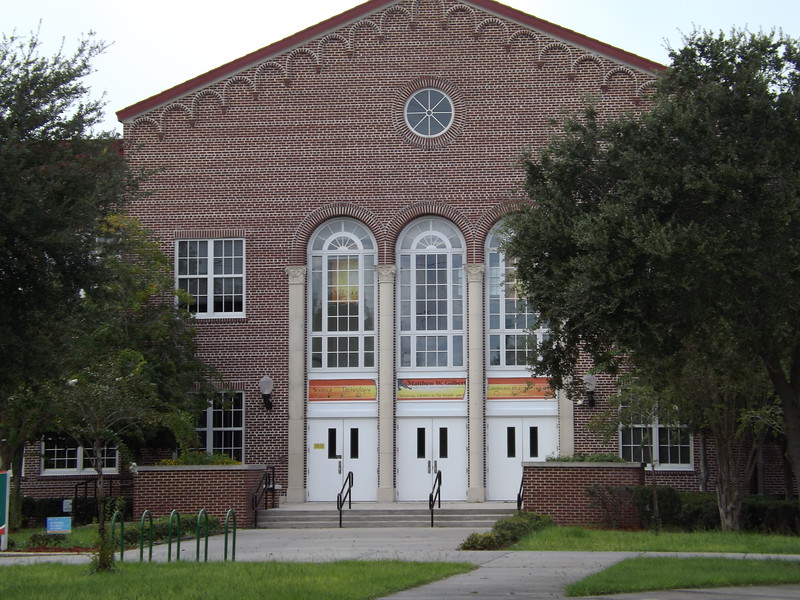
Also significant to the educational development of the Eastside was the Florida Baptist Academy. Initially founded as the Florida Baptist Institute in Live Oak in 1879, the school was expanded to Jacksonville after shots were fired into one of its buildings in 1892. It was then renamed the Florida Baptist Academy by its president, the Rev. Matthew Gilbert, and classes were held in the basement of Bethel Baptist Church under the direction of instructor Sarah Ann Blocker. Of note, Rev. Gilbert’s son, the Rev. Ralph Gilbert would go on to become one of Savannah, Georgia’s most prominent civil rights leaders after helping to establish its National Association for the Advancement of Colored People chapter in the early 1940s.
Nathan White Collier, who became president of the academy in 1896, would head the institution for over four decades. He recruited Jacksonville native J. Rosamond Johnson to teach music at the school. While teaching here, J. Rosamond Johnson put his brother James Weldon Johnson’s poem “Lift Ev’ry Voice and Sing” to music for the first time. Later known as “the Negro National Anthem,” the song was sung for the first time by a choir that included students from the academy during a celebration of President Abraham Lincoln’s birthday in 1900.
In addition, President Theodore Roosevelt once visited the Florida Baptist Academy campus, where he delivered a speech in 1905 in the presence of close friend and Eastside resident Joseph E. Lee. The school was also associated with prominent businesswoman and community leader Eartha M.M. White. The school relocated to St. Augustine in 1918. It became the Florida Normal and Industrial Institute and would later be incorporated as part of the Florida Normal and Industrial and Memorial College by 1942. Civil Rights Era activism by its students led to troubles with St. Augustine officials, however, which prompted the school to relocate to a 48-acre parcel in the Miami area, becoming Florida Memorial College by 1968. The school’s charter was later amended in 2004, at which time it was renamed Florida Memorial University.
Florida Avenue was a Chitlin’ Circuit destination

An early streetcar route, Florida Avenue emerged as the Eastside’s primary commercial corridor during the early 20th Century. Known as “the Avenue” by residents, Florida Avenue attracted artists and musicians traveling and performing along the Black entertainment corridor commonly known as the Chitlin’ Circuit by the late 1940s. Businesses such as the Blue Ridge Inn, Buster Ford’s Bird Land and the Pix Theater provided entertainment venues for Black performers and audiences during the height of segregation. Buster Ford’s Bird Land was operated by William Anthony “Buster” Ford, a popular DJ from local radio stations WMBR and WIVY. It hosted jazz performers after their concerts at other venues throughout Jacksonville, where they were known to play into the early morning hours.
The Pix theater opened in 1947 and was managed by Leonard E. Boyd. His wife maintained what was the area’s first ice cream parlor next door to the theater, and Boyd would go on to later open other theaters throughout Florida and the Carolinas for B&B Theaters. Now known as A. Philip Randolph Boulevard, “the Avenue” has suffered from urban renewal, expressway construction and inequitable public policy since desegregation.
Overcoming urban renewal
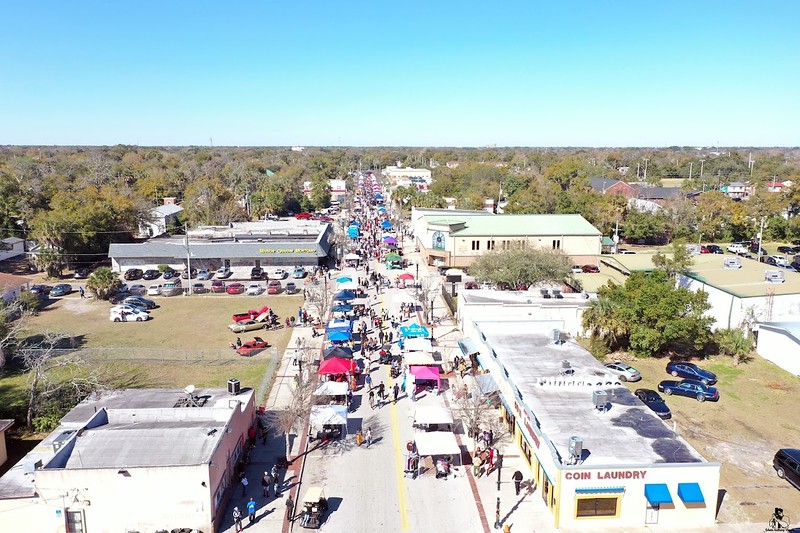
Like downtown Jacksonville, the Eastside Historic District has seen a significant number of non-historic demolitions, as a total of 467 historic resources identified in 1993 are no longer extant. These resources were spread throughout the district and were replaced with either vacant lots or non-historic infill. There has also been development pressure from the nearby Stadium and Springfield districts. According to SHPO, special consideration must be paid to the relative scarcity of intact African American resources and the impacts of urban renewal within Jacksonville. Compared to other early African American neighborhoods in Jacksonville, however, such as Brooklyn and LaVilla, the Eastside is considerably more intact and easily conveys its significant period of development despite the incremental loss of historic building fabric over the years. As a collection, the Eastside remains as one of the most intact Downtown African American districts in Jacksonville, especially east of Interstate 95. The district therefore retains its integrity for listing.
